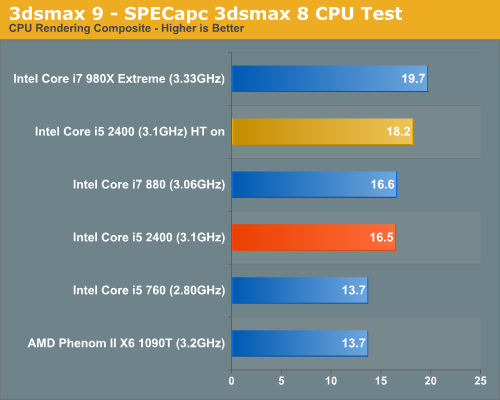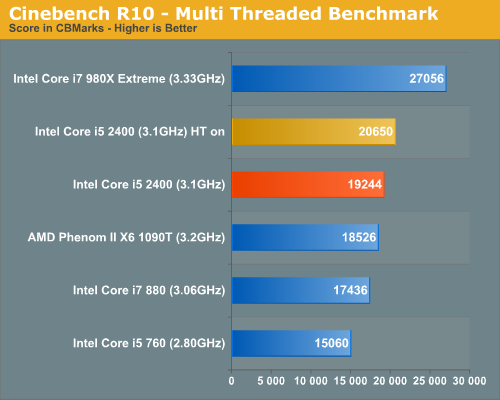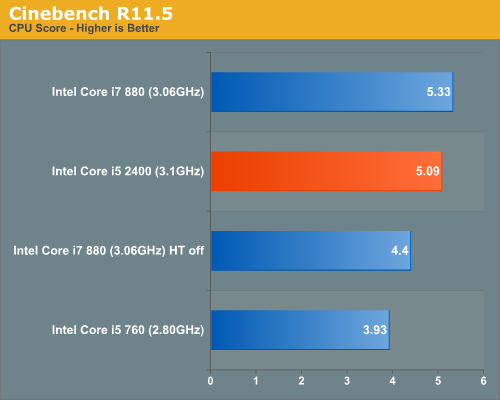The Sandy Bridge Preview
by Anand Lal Shimpi on August 27, 2010 2:38 PM EST3dsmax 9 - SPECapc 3dsmax CPU Rendering Test
Today's desktop processors are more than fast enough to do professional level 3D rendering at home. To look at performance under 3dsmax we ran the SPECapc 3dsmax 8 benchmark (only the CPU rendering tests) under 3dsmax 9 SP1. The results reported are the rendering composite scores:

This is another one of those situations where the Core i5 2400 without Hyper Threading is able to perform on par with the Core i7 880 with Hyper Threading. Compared to the i5 760 it’s 20.5% faster.
With Hyper Threading enabled, the Core i5 2400 is actually dangerously close to the 6-core 980X. Whatever Intel has done to Sandy Bridge's FP is big.
Cinebench R10
Created by the Cinema 4D folks we have Cinebench, a popular 3D rendering benchmark that gives us both single and multi-threaded 3D rendering results.

Cinebench was particularly surprising because it gives us a good opportunity to look at single threaded FP performance. Compared to a similarly clocked Lynnfield, Sandy Bridge can deliver 11% better performance. Compared to a similarly positioned Lynnfield, Sandy Bridge is about 20% faster. Note that this is without turbo enabled. The retail 3.1GHz chip should turbo up to 3.4GHz in this test, giving it a 9.6% frequency boost.
In the multithreaded test Sandy Bridge’s per-core performance is even better than Lynnfield with HT enabled.

I also ran a few numbers using Cinebench R11.5. I didn’t have the opportunity to test the i5 2400 with HT enabled in this test so I measured performance of the i7 880 with HT enabled/disabled to compare per-thread performance.

Sandy Bridge's FP performance is very good. Clock for clock we see a 15.6% improvement over Lynnfield (4C/4T vs. 4C/4T). Compared to the proposed similarly priced Core i5 760, the i5 2400 would be 29.5% faster.
POV-Ray 3.73 beta 23 Ray Tracing Performance
POV-Ray is a popular, open-source raytracing application that also doubles as a great tool to measure CPU floating point performance.
I ran the SMP benchmark in beta 23 of POV-Ray 3.73. The numbers reported are the final score in pixels per second.

The similarly positioned/priced Core i5 760 is beat by 17%. There’s no replacement for more cores/threads however as the i7 880 and X6 parts both pull ahead. Turn on HT to level the playfield (at least within Intel) and Sandy Bridge is 15% faster than Lynnfield.










200 Comments
View All Comments
AndreC - Saturday, August 28, 2010 - link
Hi there.. I`m currently a freelance 3D generalist.. and I was going to upgrade my old Core 2 Quad QX6700 with a Core i7 980X. But now i`m not that confident. Sandy bridge looks amazing, I was sad seeing the new socket for sandy bridge, it does not compell me to buy a new motherboard now... does anyone know if the 1366 socket will stick with the nex gen High end market? I dont want to shoot myself in the foot here.AndreC - Saturday, August 28, 2010 - link
Sorry dind`t read the last frase...Great Review btw. cheers
sdsdv10 - Saturday, August 28, 2010 - link
As noted in the Intel roadmap in the article, for at least part of 2011 they will be sticking with 1366 for the release of the Core i7 990X (to replace the 980X). However, after that the Intel performance platform will switch over to socket LGA-2011. Here is a quote from the articlea (page 3)."Original Nehalem and Gulftown owners have their own socket replacement to look forward to. In the second half of 2011 Intel will replace LGA-1366 with LGA-2011. LGA-2011 adds support for four DDR3 memory channels and the first 6+ core Sandy Bridge processors."
AndreC - Saturday, August 28, 2010 - link
Yeah.. as I said "Sorry dind`t read the last frase..." but thx anyway..It`s a shame to be always changing sockets, but probabily a necessity to evolve the technology.
Kaihekoa - Saturday, August 28, 2010 - link
Having the first chips target the mainstream market is a very smart move by Intel because that's where AMD makes it's money. I'm honestly not impressed by the performance numbers, but I am impressed by the overall performance, power consumption, and pricepoints for these next gen CPUs. What I'm really looking forward to is the performance segment of Sandy Bridge.mino - Saturday, August 28, 2010 - link
Intel's mainstream is not where AMD's is.Especially in 2011.
Ontario:
. . . CPU - above Atom, under everything else
. . . GPU - 5450/Sandy class
Lliano:
. . . CPU - 2C Sandy class
. . . GPU - 5650 class (at least 3x Sandy)
Bulldozer Desktop(8C):
. . . CPU - 4C Sandy Class
. . . GPU - discrete 5750+ class
So basically AMD's platform in the Intel's "mainstream" $200+ class will be a Bulldozer with discrete GPU. Aka AMD's high end stuff.
silverblue - Saturday, August 28, 2010 - link
Not sure I agree with that. From AMD's own figures, Bulldozer is significantly faster than STARS. It would be more realistic to expect Bulldozer to perform closely to Sandy Bridge, however we really need more benchmarks before we get a true idea. Bulldozer looks great on paper, but that's virtually all we have so far.In any case, you compared Bulldozer to "4C Sandy Class", which would be an 8-thread Sandy Bridge, and thus - at least relatively - high end. And I'm not getting into the core/module argument again... ;)
mino - Sunday, August 29, 2010 - link
What I wanted to point out is that Intel sees the 4C Sandy as a "mainstream" part.Reason being they are moving HUGE amounts (compared to AMD) of $150-$250 parts.
On the other hand, AMD sees the mainstream at $100-$200 and that is a Llano market.
For AMD, Zambezi is high-end that justifies discrete GPU.
And Yes, Bulldozer 8C should compare with 4C Sandy favorably, (it would mostly go to pricing).
tatertot - Sunday, August 29, 2010 - link
BD 8C is going to be up against 8C and 6C Sandy on LGA-2011 in the client space.mino - Monday, August 30, 2010 - link
am sure AMD WOULD like it that way. But no. Not really.8C Bulldozer versus 6C Sandy might actually be competitive.
However 32nm SOI is a new process so we might as well forget about 4GHz parts for now.
Also, Sandy 6C is Q4 part and 8C is most probably 2012 part.